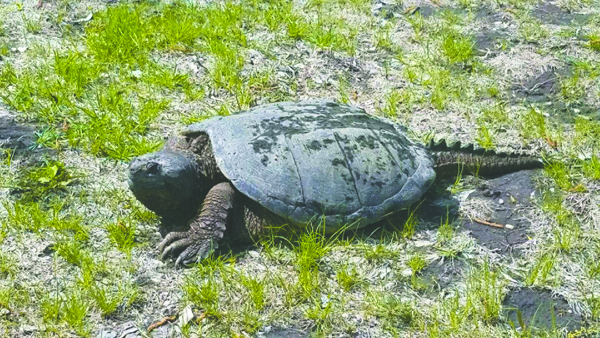The smell is natural, but the coulee isn’t

A snapping turtle was recently spotted near the English Coulee.
August 29, 2017
The familiar “rotten-egg” smell of the English Coulee is the result of sulfate in the water that converts to hydrogen sulfide gas when it reacts with organic matter.
Dr. Phil Gerla is an associate professor of geology and eological engineering at the University of North Dakota.
“It’s nothing unnatural,” Gerla said. “If you go out to a totally natural wetland and dig around in the mud, you can smell hydrogen sulfide as well.”
However, the majority of the Coulee’s water originates from storm runoff that was drained through pipes into the coulee. “Anything that’s deposited out on the streets and lawns will make its way to the coulee,” Gerla said. “It’s undergoing natural processes, but it’s not a natural system because it’s picking up contaminants from around town.”
Some of the more notable elements of the Coulee’s ecosystem include creatures like otters, bullheads and common snapping turtles that laid eggs this past spring.
Paige Hanson, a biology student and research assistant to Dr. Turk Rhen, spent the summer studying the eggs collected from one of the snapping turtles. Hanson said the eggs were nested about 50 yards from the Coulee in hard, dry dirt.
“Someone called us and said ‘we saw a turtle nesting, you should come and grab them because we don’t think they’re gonna survive,’” Hanson said. “It took the turtle who laid them an hour to get back to the Coulee.”
Some of the 80 eggs began hatching last week, and Hanson said about 80 to 90 percent of the eggs will hatch. This indicates that the water of the Co
ulee was healthy enough to have little impact on the eggs themselves.
Though, the shape of the eggs was abnormal and the number of eggs was almost double the normal amount. Hanson said the shape of the eggs is a result of the hard ground and the high number is more indicative of the age of the turtle.
Hanson said that her lab has released turtles into the coulee before, but questioned whether or not they could survive. “I didn’t even know she lived in the coulee until we found her eggs,” Hanson said.
Dylan Young is a Master’s student at UND. Despite the water being safe for wildlife, he said he wouldn’t swim in the water. “It’s disgusting and smells at times,” Young said. “If it had more free-flowing water, it’d be very nice.”
Gerla said the university has made efforts to improve the conditions, but the issue is difficult to deal with. One of the more recent projects was the addition of the floating garden pads. This effort was conducted by students in UND’s Environmental Restoration Club to aerate the water and remove nutrients brought in through storm runoff.
“The floating islands are actually working quite well, but they’re certainly not big enough to manage all of the nutrients in the coulee,” Gerla said.
Students and faculty aren’t the only force bringing new plants to the Coulee’s ecosystem. There are invasive and exotic plant species along the coulee, more notably Purple-loosestrife.
“It looks really pretty, but it’s taking over the coulee very rapidly,” Gerla said. “From what I can tell, it looks like it’s out of control this year.”
One option is to “flush” the Coulee. This would be done to improve the water quality if a summer doesn’t bring regular heavy rain.
Another option is to remove the dams from the waterway, removing the possibility of having standing ponds during dryer seasons. This would bring the Coulee to its original state of being a grassy waterway later in the year, but only having flowing water in the spring. “People wouldn’t like that, because then the Coulee wouldn’t have water in it most of the time,” Gerla said.
Removing the dams would also threaten the fish and wildlife that currently reside in the Coulee. There are no current plans to remove any dams from the
waterway.
Jacob Notermann is a staff writer for The Dakota Student. He can be reached at jacob.notermann@und.edu


